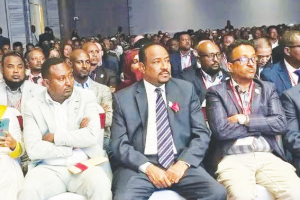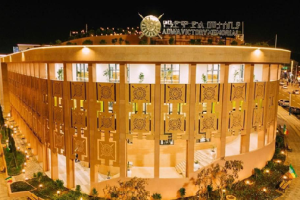BY MULUGETA GUDETA
Ethiopian literature has been characterized for many centuries by the unchallenged sway Ge’ez or the language of the Ethiopian Orthodox Church held over all aspects of intellectual life including literature. Ge’ez literature largely dealt with the lives and miracles of saints and angels and largely consisted of church chronicles, so to say.
It hardly dealt with secular themes and the lives of ordinary Ethiopians. Amharic, although an offshoot of Ge’ez, later on made a sharp break with this ancient tradition and started to serve as a vehicle for the feelings, emotions, aspirations and hopes and frustrations of ordinary Ethiopians.
However, it took a long time and the emergence of a rather secular intelligentsia in Ethiopia, for this to happen. The introduction of modern education and together with it, the advent of Western culture and ways of thinking and writing were decisive factors in this process.
The first full-length, and what some critics consider to be the first modern Amharic novel is called Tobia by Afewerk Gebretyesus. Literary commentators generally consider Tobia the first modern novel in Amharic, with a fully developed plot, imaginary characters, settings and dialogue . . . etc.
The Amharic short story dates back to an even later period. Critics maintain that the first published Amharic short story did not appear before ye gulelew sekaram (The Drunkard of Gulele), published some fifty years ago. This editor has included it in this first anthology. This is to show how story writing in Amharic began and changed eventually.
The 1950’s and 1960’s have witnessed the spread of written Amharic literature in the forms of novels and short stories. It was during this time that what many consider to be an Amharic classic, namely the novel by the foremost Ethiopian writer Haddis Alemayehu appearedunder the now household name of fikir eske mekabir (Love unto Death). although Haddis Alemayehu is a novelist, he has also written folk tales or fairy tales akin to the famous fables by French writer La Fontaine.
A collection of fables by Addis Alemayehu was first published by Kuraz Publishing Agency in 1960 under the title teret teret yemeseret. This editor has taken the story from chapter five of the collection. He has done so both for the tale’s merit and the author’s special consideration for it in the introduction to the same collection.
Ba’alu Girma is an Ethiopian writer noted for his fine literary style and language. He has influenced quite a number of younger writers and suddenly disappeared from the literary scene under mysterious circumstances back in 1984. He was the modern Amharic novelist and stylist par excellence.
Ba’alu has written one short story during his literary career. He sent it to a defunct Amharic language magazine known as Yekatit (February). This was on the eve of the publication of the ill-fated Oromay (1985) with which he is alleged to have criticized the former officials and paid for it with his life.
His story appeared under the title yefitsame mejemeria (The Beginning of The End). This editor has translated and included it in this collection.
Some of the other authors in this anthology are younger ones. Most of them emerged in the late 1980’s. They experimented with style, subject matter and language.
The editor has selected these stories for their intrinsic merit. This editor also believes they are representative samples of the modern Amharic short story in the period that witnessed its unique flourishing.
Daniachew Worku wrote short stories both in English and in Amharic. He has also written a classic novel in Amharic called Adefris. He is the author of another novel in English in the African Writers Series entitled The Thirteenth Sun.
I have discovered one of his stories in a now defunct bilingual magazine called Guramayle and I have included it in this collection. I would like to thank the editors of the magazine.
The idea of producing this collection dawned on me way back in 1993. I had the conviction that Amharic literature – or any literature in any of the Ethiopian languages for that matter – deserved to be accessible to the non-Amharic reader.
I thought it should also serve as additional reading material for students of English in Ethiopian schools. These stories, both by their narrative techniques and subject matter, are closer to the lives and experiences of Ethiopian students and readers than, say, the stories by Nathaniel Hawthorn, Anton Chekhov or Guy de Maupassant.
This is perhaps the first attempt to produce a book of Ethiopian stories in English. One will have to make similar efforts in this direction in the future too. English is the international lingua franca. It is a vehicle of universal culture, science and technology.
It is here to say and the best way to learn it might be to blend it with local cultural colors. This is often the case in developing countries where English is a second language or a medium of instruction in schools and universities.
The editor would like to thank all those who supported the idea of producing this book with enthusiasm. His thanks also extend to those who generously allowed him to include their works in this anthology. The selection or any shortcoming in translation is entirely the responsibility of the editor.
English as a language and vehicle of literature was introduced in Ethiopia under the reign of emperor Haile Selassie in early 20th century and more particularly and systematically after the end of WWII and Ethiopia’s diplomatic alliance with Great Britain and the United States.
Modern education in Ethiopia and English as a medium of instruction, along with the school curriculums, were imported from these countries. Ethiopian writers who emerged subsequently benefitted from scholarships according by the governments of Western countries and other institutions. They had the opportunity to read a great deal and introduce themselves with the great literary traditions in these countries.
If we take one example, Dagnachew Worku’s Amharic novel entitled Adefres is technically close to stream of consciousness narrative technique that was introduced in the West a long time ago but remained unknown here in Ethiopian literary circles.
The stream of consciousness technique requires greater literary maturity not only on the part of the writer but also on the part of the reader. One is bound to get confused with the story and the characters unless prior knowledge of the technique is available. Ethiopian literary tradition from Tobia to Oromay is based on realism or naturalism.
As it could be expected, Dagnachew Worku’s stream of consciousness narrative technique in Adefres could not be readily understood by ordinary readers who could not enjoy the book although it later became very popular.
The sales of Adefres were so poor that the author was angered and collected all copies of the book from all bookshops and kept them at his home. It took time for the book to enjoy the popularity it deserved.
The same fate was encountered by James Joyce’s Ulysses or Finnegan’s Wake in Britain after its publication and it required hard work on the part of literary critics to unravel the meaning of the novel and made it accessible to ordinary readers. Unfortunately, we had no literary critics worthy of the name to decipher Dagnachew’s book that remains misunderstood or mysterious down to this day.
We can perhaps mention Haddis Alemayehu, the most important post-war Ethiopian novelist in Amharic as one of the few writers who were exposed to foreign cultures and arts as he was an ambassador earlier in his career. It was in India where he was posted as ambassador that the author started to work on his voluminous masterpiece that took him more than 20 years of his life to complete, working on and off over the decades.
Haddis Alemayehu had also written a very popular and allegorical short story in Amharic entitled “ye’demetochena ye’ayitoch torenet” that was translated in English as, “The War of Cats and Mice”. Another English version of the story was produced by this columnist but remains unpublished to this day.
Ethiopian literature, mainly oral literature, is rich with allegorical narrations that used animal characters as personification of the good, the bad and the evil in human nature and action.
The allegorical method was often used to by Ethiopian writers in order to go round censorship whenever they were dealing with critical issues that were unacceptable by the authorities. Abe Gubegna, another prominent writer of the older generation, was also known for writing allegorical or implausible novels such as aleweledem (I will not be Born) whose main character is an unborn child choosing to stay in his mother’s womb instead to being born in this cruel world.
This was an indirect reference to the political and economic realities, the oppression that was evident in Ethiopia under the last monarchy.
The Ethiopian Herald January 8/2021




